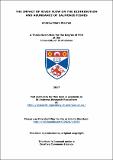Files in this item
The impact of river flow on the distribution and abundance of salmonid fishes
Item metadata
| dc.contributor.advisor | Smith, Carl | |
| dc.contributor.author | Warren, Andrew Mark | |
| dc.coverage.spatial | x, 295 p. | en_US |
| dc.date.accessioned | 2017-08-30T14:26:58Z | |
| dc.date.available | 2017-08-30T14:26:58Z | |
| dc.date.issued | 2017-12-07 | |
| dc.identifier | uk.bl.ethos.722989 | |
| dc.identifier.uri | https://hdl.handle.net/10023/11569 | |
| dc.description.abstract | River flow regime is fundamental in determining lotic fish communities and populations, and especially of salmonid fishes. Quantifying the effects of human induced flow alteration on salmonids is a key question for conservation and water resources management. While qualitative responses to flow alteration are well characterised, a more intractable problem is quantifying responses in a way that is practical for environmental management. Using data drawn from the Environment Agency national database, I fitted generalised linear mixed models (GLMMs) using Bayesian inference to quantify the response of salmonid populations to the effects of impounding rivers, flow loss from rivers due to water abstraction, and the mitigating effects of flow restoration. I showed that in upland rivers downstream of impounded lakes, the magnitude of antecedent summer low flows had an important effect on the late summer abundance of 0+ salmonids Atlantic salmon (Salmo salar) and brown trout (Salmo trutta). In contrast, the abundance of 1+ salmon and brown trout appeared to be largely unresponsive to the same flows. I demonstrated that short-term flow cessation had a negative impact on the abundance of 1+ brown trout in the following spring, but that recovery was rapid with negligible longer-term consequences. I further established that flow restoration in upland streams impacted by water abstraction provided limited short-term benefits to salmonid abundance when compared with changes at control locations. However, while benefits to salmonid abundance were limited, I detected important benefits to the mean growth rates of 0+ and 1+ brown trout from flow restoration. I discuss the implications of my findings for salmonid management and conservation and propose a more evidence-based approach to fishery management based on robust quantitative evidence derived using appropriate statistical models. The current approach to flow management for salmonids requires revision and I recommend an alternative approach based on quantitative evidence. | en_US |
| dc.language.iso | en | en_US |
| dc.publisher | University of St Andrews | |
| dc.rights | Attribution-NonCommercial-NoDerivatives 4.0 International | * |
| dc.rights.uri | http://creativecommons.org/licenses/by-nc-nd/4.0/ | * |
| dc.subject | Salmonid | en_US |
| dc.subject | River flow | en_US |
| dc.subject | GLMM | en_US |
| dc.subject | River management | en_US |
| dc.subject | Salmon | en_US |
| dc.subject | Trout | en_US |
| dc.subject | Bayesian | en_US |
| dc.subject.lcc | QL638.S2W28 | |
| dc.subject.lcsh | Salmonidae--Effect of human beings on | |
| dc.subject.lcsh | Salmonidae--Behavior | |
| dc.subject.lcsh | Streamflow | |
| dc.title | The impact of river flow on the distribution and abundance of salmonid fishes | en_US |
| dc.type | Thesis | en_US |
| dc.type.qualificationlevel | Doctoral | en_US |
| dc.type.qualificationname | PhD Doctor of Philosophy | en_US |
| dc.publisher.institution | The University of St Andrews | en_US |
The following licence files are associated with this item:
This item appears in the following Collection(s)
Except where otherwise noted within the work, this item's licence for re-use is described as Attribution-NonCommercial-NoDerivatives 4.0 International
Items in the St Andrews Research Repository are protected by copyright, with all rights reserved, unless otherwise indicated.


